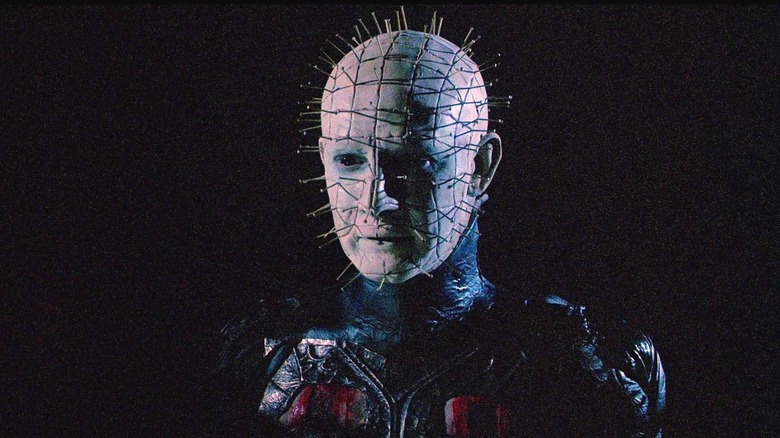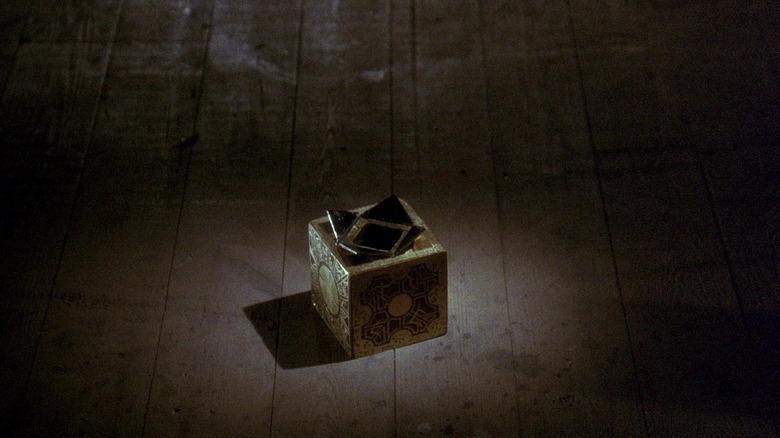The Correct Order To Watch The Hellraiser Movies
Clive Barker's 1987 film "Hellraiser" has always existed a little off to the side of the usual rogue's gallery of 1980s horror slashers. Its central demon, originally credited as Lead Cenobite (Doug Bradley), is usually mentioned alongside other notorious cinematic serial killers like Michael Myers from the "Halloween" movies, Jason Voorhees from the "Friday the 13th" movies, and Freddy Krueger from the "Nightmare on Elm Street" movies ... but he is not quite the same. The Lead Cenobite, better known as Pinhead, isn't a vicious killer who murders teenagers, but a sex deity, culled from a parallel dimension where physical pain has become indivisible with sexual pleasure. Pinhead will definitely kill you, but he will do so with extreme kink. The nails in his face were placed there as part of an extreme S&M game.
"Hellraiser" began its life as "The Hellbound Heart," Barker's 1986 novella. His film adaptation isn't quite as sexed-up, nor as weirdly mystical, but it does capture a fascinating and deep mythology. There is a centuries old puzzle box drifting through the S&M underground that, when solved, mystically summons the Cenobites, a near-religious order of immortal sadomasochists who torture you to death as a sexual maneuver. They then absquatulate with your soul back to the netherrealms. Certain curious seekers can be made into Cenobites, although many are trapped in Hell for continuous torture.
Barker produced a sequel to "Hellraiser" in 1988 and "Hellbound: Hellraiser II" might be one of the best movies of its decade. The series continued to roll forward, however, and nine additional "Hellraiser" films have been made since "Hellbound," all of diminishing quality.
If one wants a marathon, one should watch the 11 "Hellraiser" movies in the following order.
The release order of the Hellraiser movies
The release order is as follows:
- Clive Barker's "Hellraiser" (1987)
- "Hellbound: Hellraiser II" (1988)
- "Hellraiser III: Hell On Earth" (1992)
- "Hellraiser: Bloodline" (1996)
- "Hellraiser: Inferno" (2000)
- "Hellraiser: Hellseeker" (2002)
- "Hellraiser: Deader" (June 7, 2005)
- "Hellraiser: Hellworld" (September 6, 2005)
- "Hellraiser: Revelations" (2011)
- "Hellraiser: Judgment" (2018)
- David Bruckner's "Hellraiser" (2022)
The first two "Hellraiser" films were made in England and were directly overseen by Barker himself. The third and fourth were American productions released in theaters by Dimension Films (the horror arm of Miramax), with Barker only serving as an executive producer; "Hell on Earth" is more reminiscent of a traditional slasher movie than its predecessors, while "Bloodline" did a wonderful job of folding the third film's oversimplified premise into the series' larger narrative. "Bloodline," however, was a notoriously hatcheted affair, and director Kevin Yagher removed his name from the film; it's credited to Alan Smithee.
The fifth through tenth "Hellraiser" movies were all straight-to-video films, and many of them changed the S&M-based premise. It was previously established that Hell was a sexual realm reserved for bondage enthusiasts with a penchant for blood. From "Inferno" on, Hell is transformed into a more traditional Christian Hell, where "sinners" go when they die. This old-fashioned version of Hell made for less interesting stories. Indeed, "Inferno," "Hellseeker," and "Deader" all feature the same plot: the a-hole protagonist is haunted by surreal images of hell as they investigate a mystery. At the end, it's revealed they were in Hell all along. Snore.
"Hellworld" takes place in the "real" world and is set during a "Hellraiser"-themed party where the guests are being murdered by a serial killer. No points for originality.
You only need to watch the first two Hellraiser movies (or the first four, if you're ambitious)
"Hellworld" only reveals itself to be a legit "Hellraiser" movie in its epilogue, wherein actual Cenobites appear. Before that, the Cenobites are explained away as hallucinations.
"Revelations" and "Judgment" are unique in that they didn't invite Doug Bradley on board to continue playing Pinhead. "Revelation" featured Stephan Smith Collins in the role, with the voice provided by Fred Tatasciore. "Revelations" is essentially a soft reboot of the 1987 original, featuring similar conceits. The original, recall, featured Julia (Claire Higgins) finding the half-desiccated and still-living semi-corpse of her ex-lover Frank in the attic of her new home. He was once taken away by the Cenobites, but was able to return thanks to some spilled blood on the floor where he was killed. Unbeknownst to her husband (Andrew Robinson), Julia lures men to "feed" to Frank, helping him restore his flesh.
"Revelations" also features a Hell escapee who is fed victims — this time Mexican sex workers — so that he can re-grow his skin.
"Judgement" is a Heaven vs. Hell story, and might only be notable for its early scenes wherein the oddball bureaucracy and filing system of Hell is laid bare; it involves vomit and topless women. Pinhead is played by Paul T. Taylor. He's fine, but neither he nor Collins have the same authority as Bradley.
A new version of Pinhead was introduced in the 2022 "Hellraiser" reboot. This time, Pinhead was played by Jamie Clayton, and the movie featured a new mythology. The puzzle box — the Lament Configuration — had several wish-fulfilling functions and sex was no longer part of the equation. It's the best "Hellraiser" since "Bloodline."
Watch them. They have such sights to show you.


